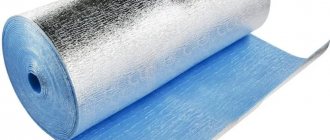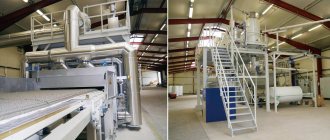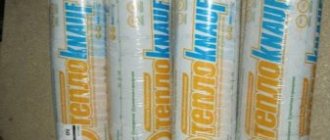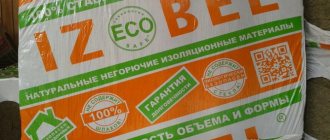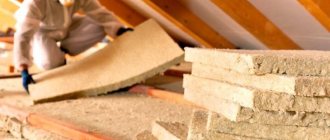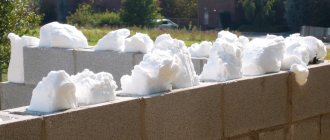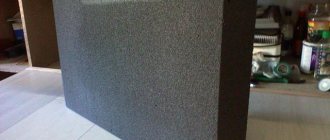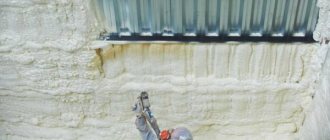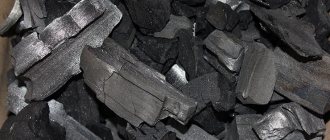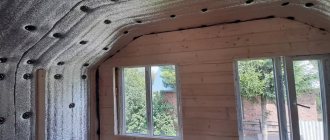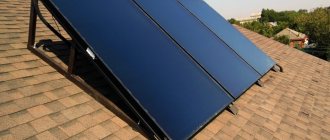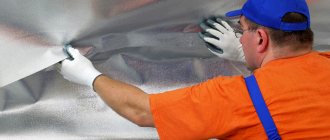Proper insulation with penofol on the outside of a wooden house helps to transfer the dew point beyond the boundaries of the wooden walls, which in turn protects the building itself from the harmful influence of the external environment. Why is this happening? Because the freezing of wooden walls is not uniform (especially if we talk not about the perimeter, but about the thickness of the material).
Only the outer surface is characterized by negative temperatures, which provokes the formation of moisture, which acts as a destroyer on the structure. In addition, wood slowly absorbs and accumulates moisture, which leads to mold beginning to multiply throughout the material.
What it is?
Penofol is a two-layer heat-insulating building material, which can be made from one or 2 layers of foil applied to a base layer of polyethylene foam. Depending on the type of product, the density and thickness of the foam may vary. Utilitarian and inexpensive insulation is in great demand among buyers, because it has high performance characteristics.
A layer of foil, the thickness of which is 20 microns, provides penofol with excellent heat-reflecting qualities.
This insulation is used in everyday life and industry as the main insulating material or as an auxiliary thermal insulation layer.
Penofol is used as the main insulating material in cases where it is necessary to insulate a room with normal heat loss and where there is a powerful heating source (bathhouse, sauna, underfloor heating system in a wooden house). As an additional insulating building material, penofol is used to create complex heat insulation in residential and industrial premises, and such premises must be equipped with vapor barrier and waterproofing.
Installation features
Laying penofol is carried out with the foil side always towards the heat, so that it could be reflected into the room. To eliminate the risk of condensation, a ventilation gap of at least 10-20 mm wide is formed on this side. The edges of adjacent workpieces are joined closely without overlap. To ensure the integrity of the protective layer, the seams are additionally sealed with aluminum vapor barrier tape.
sealing seams with aluminum tape Source neoenerg.ru
For walls, it is recommended to choose samples up to 5 mm thick with one foil side. If such a fabric is insufficiently effective, you should first insulate the room with penoplex. It is better not to use mineral wool boards in order to avoid assembling additional sheathing.
Penofol can be attached to walls by gluing it to a clean primed surface or using a construction stapler (with staples). A counter-lattice made of slats or plywood pieces is mounted on top of the insulator. Drywall, chipboard or other rigid sheet materials are sewn onto the finished frame.
Advantages and disadvantages
The use of penofol has its advantages:
- The small thickness of the material allows you to create reliable thermal insulation of the room.
- Installation of building materials does not require special skills or special tools. Working with this material is much easier than with other types of insulation.
- The material is environmentally friendly, which makes it possible to use it for storing food.
- Fire safety. This building material belongs to the class of fire-resistant materials.
- Ease of transportation. The thickness of the product allows the insulation to be rolled up, which allows it to be transported in the luggage compartment of a car.
- Excellent sound insulation. Mounting penofol on top of the frame of building structures provides good insulation of extraneous sounds.
Penofol has not only positive qualities. There are also disadvantages to using this building material:
- The insulation is soft. Because of this, this product is not used for finishing plastered walls. When lightly pressed, the material bends.
- To fix the insulation you will need special adhesives. It is not recommended to nail it to the surface, because in this way penofol loses its thermal insulation qualities.
Real thermal insulation characteristics
At the beginning of the publication, we mentioned the overestimation of the performance parameters of the material by unscrupulous sellers. Common myths about the properties of an insulator look like this:
- Innovative insulation "Penofol" has the best thermal insulation characteristics. The thermal resistance R of a 4 mm thick sheet reaches 1.2 m² • °C/W, which is comparable to 0.67 meter red brick masonry or 46 mm polystyrene foam.
- The Penofol layer serves as excellent sound insulation.
- The insulation can be freely filled with cement-sand screed, turning the foil up.
Material with an adhesive layer on the back side (type C)
Reference. The manufacturer claims: for the most effective operation, the heat insulator must be placed inside a closed air gap. When installed close to other materials, the aluminum coating will not perform its function of reflecting radiant heat. Infrared waves can penetrate open space, but not thick concrete.
The heat transfer resistance of one insulating layer can be easily calculated using the classic formula from the building thermal physics course:
- R – the value of the thermal resistance of the material, m² • °C/W;
- δ – insulation thickness, m;
- λ – coefficient of specific thermal conductivity, W/(m • °C).
Substituting the manufacturer's data into the formula (we take the optimal option), we get R = 0.004 mm / 0.037 W/(m • °C) ≈ 0.11 m² • °C/W. Knowing the thermal conductivity of the foam (λ = 0.043), it is easy to determine the appropriate layer thickness: 0.11 x 0.043 = 0.0047 m = 4.7 mm. Roughly speaking, 5 mm of polystyrene foam and 4 mm of polyethylene foam will retain the same amount of heat; there is no talk of 46 mm.
Types of Penofol
There are:
- Penofol "Type A" - aluminum foil on one side, the most widely used option.
- “Type ALP” - the foil is covered with a protective polymer film - is used when contact with concrete, which is aggressive towards aluminum, is possible.
- “Type B” - foil on both sides.
- “Type C” - on one side there is foil, on the other side there is an adhesive layer - the material can be glued to the surface.
- The material with foil, but perforated, is capable of passing steam through it in large quantities; there is no data on vapor permeability from the manufacturer.
There are 3 main types of penofol depending on production technology, dimensions and technical characteristics:
Type A
Polymer insulation material of varying thickness, foil is applied only to one side of the building material. This type of insulation is popular in complex insulation of building structures; it can also be combined with some insulation materials: glass wool, mineral wool.
Type B
Insulation covered with foil on both sides. Thanks to this design, the material has maximum insulation effect.
This type of insulation is used for thermal insulation of load-bearing structures of the attic, waterproofing of basements, floors and walls. Foil material placed under the roof prevents heat from entering the room.
Type C
Self-adhesive penofol, which is covered with foil on one side, and on the other, a thin layer of adhesive composition covered with film is applied to it. Depending on the dimensions of the product, it can be used on almost any surface, which saves time. Before starting work, this building material must be cut into strips of a certain size.
Regular penofol (types: A, B, C) has a white base, while penofol 2000 has a blue base.
There are several other types of penofol, which are not in great demand among consumers.
Type R
One-sided insulation, which has a relief pattern on the foil side of the insulation. It is similar to penofol type A, but is mainly used as a decorative special element for finishing premises.
There is penofol without a foil coating, which does not have a corresponding type, but builders call it a substrate for laminate (linoleum).
This type of insulation has a low cost and is mainly used for thermal insulation of special floor coverings.
Insulation materials with a narrow direction:
- ALP is a material laminated with polyethylene film. Has high reflective properties. Used for insulation of incubators.
- NET - this type of insulation is similar to type B, produced in narrow roll sheets. Used to insulate pipelines.
A novelty in the field of manufacturing polymer insulation materials is perforated penofol. This building material is able to breathe, because it has a large number of micro-holes. Often used to insulate wooden structures.
How to choose penofol
It is recommended to consider the following criteria for choosing penofol:
- The price by the thickness, as well as how many layers of aluminum were applied to the reflective surface. The standard size is from three to eight and even ten mm. Penofol with one side - a reflector with a size of 3 or 4 mm, type A - can cost approximately up to 55 rubles / m². 10 mm type B is considered much more expensive and more durable of all; the cost for it can reach from 100 to 130 rubles/m² .
- In stores you can come across the label “Penofol 2000”. We are talking about an analogue of standard material, but cheaper (it costs from 35 rubles/m² ). In terms of strength, according to experts, it is much inferior to classical insulation.
- The best ratio between the cost of the substance and the performance data is shown by penofol 5 mm thick at a cost of approximately 70 rubles / m².
- When you need to insulate the roof or basement rooms, in the basement, on the balcony, for saunas, or walls and ceilings, you can use A-type penofol. When used on wooden floors, it is better to take B-class. C-class is used for metal structures and vehicle insulation.
Thermal insulation qualities of Penofol
It should be noted that when compressed to 2–3 times the original thickness, air is partially displaced from the material, and the thermal conductivity coefficient increases significantly. At the same time, reducing the thickness of the layer leads to a proportional decrease in heat transfer resistance. This means, at least, that Penofol, as insulation, should not be used in a compressed state.
On the manufacturer's website you can find the following values:
- heat transfer resistance R of PENOFOL® insulation in a structure with a closed air gap is 1.175 – 1.362 m2C/W.
Apparently, such a high value for a thin layer of insulation was obtained by adding up the heat transfer resistance of directly foamed polyethylene with a thickness of 5 - 10 mm - only 0.15 - 0.3 m2C / W, and also by adding here the heat saving from foil (a barrier for radiant heat), which completely depends on the radiation power from the inside, the temperature in the room, the presence of heating sources, the degree of absorption of radiation by structures, and also, apparently, adding the resistance of the “closed air gap” of the structure, which can actually reach 1.0 m2C/W, for example, in a double-glazed window.
However, the obvious fact is that Penofol really does insulate, all that remains is to apply it correctly.
Preparatory work
Before insulating the roof, it is necessary to go through the preparatory stage of work, which is always carried out according to the standard scheme:
Inspection of roof truss elements for damage in the form of cracks or rot. If any are found, beams, bars and boards should be replaced.
Cleaning the inner surface of roof slopes from dirt. These could be stains of rust and grease, dust, traces of mold and the like.
Coating wooden roof elements with antiseptics, fire retardants and primer.
What to glue it with?
A correctly selected adhesive solution for foil material does not yet guarantee a successful installation. For a quality connection of materials, it is necessary that the surface to be glued be carefully prepared. All defects, irregularities, and various debris must be eliminated.
To improve adhesion, materials made of metal, concrete and wood can be treated with a special primer solution.
Concrete floors and walls are leveled, cracks are sealed, and metal products are treated with an anti-corrosion agent.
Adhesive for foil insulation can be either specialized or universal. You can also use liquid nails, double-sided tape, or a thin layer of foam. The choice of glue depends entirely on the purpose of the surface and its further use.
The adhesive composition must correspond to the performance indicators of the insulating material:
- permission for indoor use;
- the toxicity of the solution should be 0;
- high resistance to adhesion;
- the glue must withstand temperatures in the range of -60 to +100 degrees.
If insulation is carried out externally, then the adhesive solution must be resistant to water vapor and liquid.
In order for penofol to be reliably glued to the surface, the glue must be applied to the side that does not have a foil layer. The adhesive solution is applied evenly, without gaps. The edges of the panel are carefully coated with glue so that the foil material does not come off during operation.
Before you start fixing the penofol, you need to wait 5-60 seconds for the glue to dry slightly. This ensures better adhesion to the products. Penofol is pressed to the surface, holding it, and smoothed out with special care.
If the insulation is glued in pieces, then the joints are additionally glued.
Is it possible to insulate from the inside?
Also, in order to further insulate, the walls are insulated from the inside with penofol. Of course, many may argue that the internal placement of insulation leads to the formation of condensation between it and the walls.
Yes, this would be so, but you need to remember that the walls outside are already insulated, so they do not freeze and condensation does not form.
Internal lathing
Insulating a house from the inside with penofol begins with stuffing slats under the insulation to allow for its convenient fastening, as well as the formation of a ventilation gap between the insulation itself and the walls of the building.
The slats are mounted on the walls using dowels, after which penofol is installed with an overlap of 10-15 centimeters and secured using a construction stapler.
Insulation
Insulating walls from the inside with penofol further consists of gluing the joints using double-sided foil tape. The insulation itself is laid with the foil side facing the room to create a heat shield. After this, I seal the insulated space; it is “sewn up” with plasterboard boards.
You just need to remember that the interior lining of an apartment/house with penofol or any other insulation without external insulation should be installed only in case of emergency, since condensation between the wall and the insulation cannot be avoided.
Maxim Bragin, Vereshchagino, 2014.
See more on this topic on our website:
- How to insulate walls with mineral wool in a wooden house from the inside The construction of residential buildings made of wood is gaining more and more popularity due to a number of specific reasons. If some people are interested in wooden houses because of aesthetics.
How to insulate a house made of timber from the outside with mineral wool. Why is it necessary to insulate a house made of timber from the outside in a continental climate? A large number of heat losses in mansions built from timber or logs is explained as follows.
How can you insulate an old village wooden house? Despite the favorable climate, buildings made of wood require additional insulation, since in the most severe frosts you can spend a lot on electricity. Among modern residents, suburban.
How to properly insulate a facade with foam plastic - let's learn together Insulating facades with foam plastic is one of the best options if you want to save on electricity and gas for heating your home. Polystyrene foam is ideal for insulation.
How can you insulate a wooden house from the inside and outside? It is believed that a house made of wood cannot allow cold to pass through, because the material from which it is made is a good heat insulator. But there are times when builders are not very conscientious.
Ceiling and roof covering
It is proposed to do preliminary insulation of attic roof slopes according to the following scheme (shown above in the drawing):
- Waterproofing - a diffusion membrane - is laid horizontally on top of the rafters, with a minimum overlap of 100 mm. The order of fastening the canvases is from bottom to top.
- The membrane is pressed against the beams with counter-lattice bars, and horizontal boards of the main sheathing are nailed to them. A roofing covering is mounted on top - metal tiles, slate, profiled sheets, and so on.
- From the inside, horizontal beams 50-60 mm thick are attached to the rafters, the installation step is 60 cm.
- Three-layer “Penofol” type B with two foil surfaces is applied to the bars. Note that the thin insulation goes around the rafters so that there is a gap on both sides.
- The internal lining - lining, moisture-resistant plasterboard, chipboard panels or other finishing materials - is vertically screwed to the ends of the bars.
Attention! The Penofol roll is rolled out vertically on the surface, adjacent sheets are laid end-to-end, not overlapping. We carefully seal the seams with aluminum tape.
To seal the joints, use a mounting tape with a width of at least 50 mm.
In this case, the insulation reflects heat flows on both sides, which is very useful in the summer, when the metal roof gets very hot. The inner layer remains unventilated, moisture from the external air is removed through the membrane. Since Penofol serves as a vapor barrier, it is necessary to organize natural exhaust in the attic using a separate ventilation duct.
Please note that there is an inaccuracy in the drawing above - there is no external counter-lattice that creates a ventilation duct above the superdiffusion membrane. In the next version of the diagram, which shows the thermal insulation “pie” of the attic roof, the frame of the sheathing is clearly visible. What is different about this cladding method:
- Between the rafters there is a thick layer of basic insulation - 120-200 mm of mineral wool.
- The bottom of the mineral wool is lined with two-layer “Penofol” type A right along the ends of the beams. The aluminum faces the inside of the attic room, the canvases are turned horizontally.
- A gap of 2-3 cm is left between the polyethylene and mineral wool insulation, and about 4 cm on the foil side.
- We nail the bars for interior finishing to the ends of the beams directly through the layer of polyethylene.
The foil surface faces the inside of the room, a gap is provided between it and the lining.
The section clearly shows that Penofol plays the role of an additional insulator and vapor barrier - traditional film is not used from the inside. The moisture formed in the mineral wool is removed through the upper vent and the waterproofing membrane. Vapors from human activity are removed by supply and exhaust ventilation.
Advice. When working with Penofol, it is important to understand the essence: we always leave a layer in front of the foil, and lay the polyethylene base close to the building structures. We connect the canvases only end-to-end.
Ceilings are insulated according to a similar principle:
- If on the attic side the wooden floor is covered with expanded clay, sawdust or reeds, it is enough to lay 1 layer of “Penofol” type B, creating gaps using lathing.
- Type C material can be glued directly to a concrete ceiling, with the foil facing down. Next, mount the frame for attaching the gypsum board or other finishing.
- When major insulation of the ceiling is necessary, use the attic scheme, only without a membrane and external sheathing. Install a frame of beams or galvanized profiles, insert the main insulation between them, then hem the bottom with type A polyethylene foam.
If Penofol is the only insulator of heat flow (which is not always correct), choose the maximum thickness of the material - 8...10 mm. In tandem with other insulation materials, a sheet with a thickness of 3-4 mm works well.
About the thickness of Penofol
The thicker the insulation, the more expensive it is. And the price and technical characteristics of foil Penofol are influenced by the number of layers of aluminum foil: there can be one or two. As for thickness, its standard sizes are: 10, 8, 5, 4 and 3 millimeters. You can understand that centimeter-thick material with a double layer of foil will be the most expensive. By the way, it not only stores heat better than anyone else, but also protects well from noise.
In terms of optimal price-quality ratio, Penofol with a thickness of 0.5 centimeters came out on top. If maximum thermal insulation, as well as protection from noise and moisture, is required, then it is better to opt for a centimeter layer of Penofol. As for the other parameters of the insulation, they also depend on the thickness of its layer, as well as on its type.
About Penofol's heat conductivity
Since this insulation is combined, combining heat reflection and absorption, it is difficult to compare it with traditional heat insulators. Penofol insulation helps reduce convection due to the polyethylene foam layer, and the foil layer on the outside can reflect up to 97% of heat rays. The result is comprehensive insulation.
And yet, let’s try to compare, if not the thermal conductivity coefficient, but the heat transfer resistance of Penofol and other insulation materials. If we take this material with a thickness of 4 to 5 millimeters, covered on both sides with aluminum foil, we get a heat transfer resistance of 1.2 to 1.23 square meters-degrees Celsius per watt. To achieve the same result, the layer of mineral wool should be no less than 8 or 8.5 centimeters. Data are calculated according to SNIP II-3-79.
About the material's absorption of water
Penofol almost does not absorb moisture, and it does not matter what humidity the air has indoors and outdoors. This does not depend on the change of season or change in temperature. This distinguishes this insulation from most modern heat insulators.
About the vapor permeability of Penofol
There is no need to lay a vapor barrier film when using Penofol. After all, its vapor permeability coefficient does not even reach 0.001 milligrams per meter-hour-Pascal. We can say that this insulation is an excellent barrier to fumes.
Sound resistance
Speaking about the sound absorption of Penofol, we can name the following number: 32 decibels. This is precisely the sound absorption that class “A” material has. It is mounted not inside the frame of the building structure, but on top of it, with no seams. Therefore, it allows you to protect yourself from various noises: both acoustic and structural. This versatility is a definite plus.
Fire protection
According to the standards, this material is classified as substances that are difficult to burn and do not support combustion. The Research Institute of Construction Physics issued Penofol a certificate of conformity confirming that the material is not a fire hazard. When burned, polyethylene releases water and carbon dioxide. True, if there is not enough oxygen, carbon monoxide may appear.
Service life and safety
One of the cleanest materials in terms of ecology is polyethylene foam. Therefore, it is this that underlies Penofol. By the way, in terms of durability (200 years) this substance can be given the highest score. At the same time, you will be able to protect yourself from the harmful effects of electromagnetic radiation. They can be reduced by two or even ten times.
Balcony insulation with foam plastic
This type of thermal insulation is recommended to be installed at temperatures ranging from -5 to +30 degrees. To securely fasten it, it is recommended to use glue and fasteners. An adhesive is applied to the sheets and then pressed against the wall.
Typically, builders glue the foam using a gun filled with polyurethane foam. One cylinder is enough to treat 10 square meters.
Dry adhesive mixtures are suitable for insulating a balcony with polystyrene foam inside and out; they can be used to attach the sheets to a wooden sheathing. But dry mixtures are not suitable for fastening to concrete.
It is not recommended to use liquid nails; they do not create sufficient fixation. But nails harden quickly, so they are often used in combination with long-drying foam or glue. In this case, you will not have to put up supports to prevent the sheet from falling before the foam hardens.
To secure the foam securely, it is advisable to use fasteners. They can be combined with glue or used instead. For this operation, a mushroom dowel is used, which does not cause deformation of the thermal insulation.
Insulating a balcony with polystyrene foam step by step:
- Select the dowels according to their length - they must pass through the material, a layer of glue and old plaster. Next, the fasteners penetrate the concrete to a depth of at least 50 mm, and the curvature of the wall must be taken into account. Typically, for foam plastic 50 mm thick, a dowel 110 mm long is enough.
- Holes are drilled in the foam that will be used for fixation. For 1 m2, six holes are enough - four in the corners and two in the center.
- Screw the mushroom dowel using a screwdriver; if fasteners with a nail are used, it is simply driven in with a hammer.
After installation, it is recommended to cover the foam with a mesh and apply reinforcing glue on top. You can attach trim on top of it. It is advisable that the reinforcing adhesive be made by the same manufacturer as the fastening adhesive.
When insulating a floor with polystyrene foam, logs from timber are first installed, then sheets are laid between the sheathing. The remaining gaps are sealed with polyurethane foam. The material should be flush with the wooden beam. The top is covered with plywood.
You can insulate the floor without installing a frame. But in this case, you will have to put a reinforcing mesh on top, and then make a concrete screed. This method is rarely used, since performing the screed requires some skills.
Both frame and frameless methods are suitable for attaching polystyrene foam to the ceiling. If wooden lathing is used, a layer of film must be placed between the frame and the material to avoid the formation of condensation. The foam is cut exactly to the size of the cells, since it is not subject to deformation. If the sheets are glued with glue, several additional fasteners are installed. For finishing you can use sheets of plasterboard.
Examples of incorrect and dangerous use of Penofol
- Laying Penfol under a cement (reinforced concrete) screed. The foil is destroyed by the alkaline aggression of concrete, the insulation layer is compressed excessively. There is no warming effect.
- The use of Penofol as the main insulation layer in structures that must be insulated in accordance with standards - in floors, in roofs, in walls. In this case, users are usually guided by the assurances of sellers that the material replaces “5 centimeters of polystyrene foam” or “6 centimeters of mineral wool.” As a result, without a main insulating layer (in most cases, 10 cm of effective insulation is economically optimal...), the structures remain cold.
- Application from the side of the living space directly onto Penofol, without leaving an air gap, finishing panels, wooden finishing, wood structures, which entails dampening of the finishing, mold development, wood rotting due to condensation accumulated on the vapor barrier insulation. After a year of such use, according to the owners, Penofol is “black with mold.”
- Laying inside panel structures along the foil side of the electrical wiring.
- Joining Penofol sheets leaving gaps, which, in addition to a general reduction in insulation, in some structures leaves greater air permeability (drafts), which completely eliminates the presence of an insulating layer.
How to lay penofol with your own hands
The best insulation effect is achieved if you adhere to the following rules:
- Between the structural element and the insulation itself, you need to leave some distance for the sake of ventilation, no more than a couple of centimeters.
- If you install one-sided penofol, the layer with foil should be directed in the direction where the heat will come from.
- It is better to connect sheets of material joint to joint, which gives uniformity in heat reflection. But if, for example, a loggia is insulated, joining using the overlapping method to a width of up to 10 cm is also acceptable.
- When sealing joints between sheets of materials, tape, also foil, should be used.
It is very important to remember that this material must be attached taking into account the fact that the reflective aluminum foil conducts current. Therefore, if there is wiring nearby, it is necessary to insulate the wires well.
An example of using penofol for insulating walls and floors
Once a material suitable for the operational requirements has been selected, additional waterproofing, protection from steam or heat can no longer be used. It will also be possible to save on the installation process and materials necessary for high-quality insulation and insulation of surfaces. You can also watch several videos on this topic.
Dew point problem
Ideally, the roof in the attic should be insulated from the outside at the stage of forming the roofing pie. However, often this is done the other way around from the inside, when the house is already covered with a roof. And here certain problems arise.
The correct and ideal roofing pie is several layers of different materials laid on top of the rafters tightly on top of each other without gaps. Such a sandwich ensures that the dew point will be located on its outer side. As a result, all condensate formed outside will quickly evaporate into the atmosphere.
By doing insulation from the inside, after installing the roof, it is impossible to form the exemplary roofing pie described above. It will not be possible to press the insulation onto the roof so that there are no voids left between them.
But steam always moves towards cold air. And then, each of the formed cavities will begin to accumulate condensation and moisture. And this is a direct path to damage to the thermal insulation material and wooden elements of the rafter system.
When insulating an attic internally, the dew point has to be shifted into the space between the laid roof and the insulation, leaving an additional 5–10 cm gap there for ventilation. Only such a technology and such a cake will avoid moisture in the insulating material.
To reduce the amount of water vapor in the insulation, its installation should be done using a vapor barrier film. A vapor barrier is installed from the inside of the attic on top of the thermal insulation material.
The steam must first encounter this film and mostly remain in the room. The less of it gets into the insulation layer, the better.
Which material is better?
As you know, heat is transferred from product to product in 3 ways:
- heated air;
- thermal conductivity of materials;
- radiation - heat transfer from one product to another occurs using electromagnetic waves in the infrared spectrum.
Let's look at some differences between penofol and other thermal insulation materials.
Most thermal insulation building materials (mineral wool, isolon, penoplex, tepofol) interfere with one type of heat transfer. A distinctive feature of foil material from other types of insulation is that it has a complex effect: foamed polyethylene is an obstacle to convection, and thanks to aluminum foil, the thermal reflection rate reaches 97%.
Penofol can be compared with only one group of thermal insulation materials - isolon. Comparing isolon and penofol, there is no significant difference in the quality and method of their use. To determine the winner, you need to look at the availability and price category of a particular building material. The only advantage of Izolon is that the range has been expanded with sheet building materials, the thickness of which ranges from 15 to 50 mm.
Penofol is mounted using glue, and the penoplex is fixed using fungal screws. Also, foil insulation does not accumulate heat, but rather reflects it.
Mineral wool is attached only to vertical slats. The price category of penofol is significantly lower than that of mineral wool.
Useful information and video on how to insulate an attic for winter living
A lot depends on the quality insulation of the attic roof. If you plan to use this space during the winter, you need to think carefully about what materials to use for insulation. Another important aspect is the roof design.
If the roof geometry is very complex, you may have to sacrifice some area to retain heat
The peculiarity of the under-roof space is not only in geometry; in winter it is colder here than in other rooms, and in summer it is hotter. To maintain optimal temperature, roofers recommend forming a multi-layer “pie” of waterproofing, vapor barrier and insulation under the roofing.
High-quality thermal insulation will prevent heating of the roofing material and the formation of ice
And now a short video to get a general idea of attic insulation:
Interesting Facts
A little history and other interesting facts about Penofol:
- Reflective thermal insulation was first used in the United States to create space suits.
- The name “penofol” is derived from two words: polyethylene foam (peno-) and foil (-fol).
- The metallized layer undergoes pre-treatment: polishing to a maximum reflectance coefficient (from 97%).
- The overall coefficient of resistance to thermal transfer of Penofol with a thickness of 10 mm is higher than that of a brick wall with a thickness of 54 cm.
- Each type of Penofol has its own labeling. The letter C corresponds to a self-adhesive foil roll.
- There is a way to check Penofol for quality without leaving the store. Unroll the roll and look through it at a bright light source. This way all irregularities, stripes and spots will be visible.
- You should not buy Penofol labeled 2000; it is a cheaper but lower quality material.
The construction market is overflowing with various proposals, but not all of them fully meet the requirements that apply to them. Penofol products are one of the few that you can trust. Combining several useful properties, self-adhesive foil polyethylene is able to give the room long-awaited warmth.
Foil insulation
Foil insulation is made from various porous materials, onto which a layer of metal is applied to help reflect thermal energy. This insulation works on the principle of a thermos, reliably retaining heat inside the room.
Metal is able to reflect heat and prevent blowing, which is important when using metallized insulation when carrying out exterior finishing work.
One of the advantages of foil insulation is its thickness, which starts from 1.5 cm. The most common aluminum insulation is 0.5 - 1 cm, but 5 cm or more are also found.
Even the minimum thickness of the material is enough to reliably protect the room from excessive heat loss.
Advantages
Not only the technical characteristics of Penofol indicate a large number of its advantages, there are also other advantages. An affordable price will allow you to buy a product for insulating large rooms. It is perfect for installation in a spacious living room or for use in a conference room.
Visual photos of Penofol show how simple and at the same time effective its structure is. Additional sound insulation will improve the comfort of staying or living in the room. Minimal moisture absorption indicates the possibility of installation in the kitchen.
If the roof is already covered: insulating the attic from the inside according to all the rules
Reading time: 7 minutes No time?
We will send the material to you by e-mail
Whether you are building a new structure or remodeling the roof for additional rooms, you need to take care of how to properly insulate the attic. If the roof is already covered, all work from the inside is carried out taking into account the geometry of the roof and the climatic characteristics of the region. In this material, we have collected all the necessary information about possible insulation methods and will provide you with practical recommendations from professionals.
A well-insulated attic can serve as a bedroom or even a children's room
Finally, about other use cases
Home craftsmen use insulation made from foamed polyethylene for a wide variety of purposes:
- protection of heating and hot water pipes from freezing;
- interior decoration of entrance door leaves;
- reflective screen glued to the outer wall behind the heating radiators;
- inexpensive thermal insulation of outbuildings - sheds, workshops, garages;
- exotic – shoe insoles made of 3 mm thin sheet insulation.
Polymer insulator "Penofol" is a material that deserves attention. If applied according to the instructions, it will serve as a good insulator. But do not try to save money and solve all thermal insulation problems using thin polyethylene alone; use other effective insulation materials.
Answers to popular questions
What is the best insulation for an attic under metal tiles?
Metal tiles do not place any special requirements on insulation. All types of mineral wool and foam plastics are suitable. The main condition is a sufficient layer of insulation, reliable waterproofing and vapor barrier.
Soundproofing insulation should be installed under a metal roof. Basalt wool and polystyrene foam have these qualities. In addition, roll and block insulation materials with a soundproofing substrate are produced.
How to insulate an attic if the roof is without waterproofing
If there is no waterproofing, it should be installed. With a cold roof, the absence of a water barrier is not critical - if there is no difference in the external and internal temperatures, there will be no condensation, as well as ice dams.
The waterproofing film can be laid from the inside, securely connecting the joints. In this case, the need for ventilation under the roofing should be taken into account. Therefore, there must be an additional sheathing above the waterproofing film to create a ventilation gap. If there is no gap, the roofing material is laid on the rafters, then it must be removed.
Waterproofing is laid on top, connected without gaps, sheathing is made and the roofing is installed.
Insulating the attic from the inside if the roof is already covered: work procedure and useful tips
A cold attic can be converted into a full-fledged living space. It differs from the attic in ceiling height - at least 2.5 m. Sometimes it protrudes beyond the living quarters and is supported on stilts. You can arrange an empty space yourself, following simple but mandatory rules. The arrangement of the attic should begin with the main thing - with insulation.
If the roof is already covered, insulating the attic from the inside may seem like a more complicated process. However, everything is not as complicated as it might seem, the main thing is to follow the order of work and choose the right materials.
